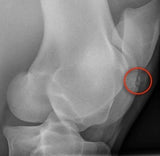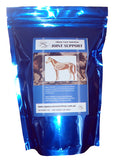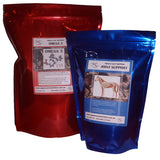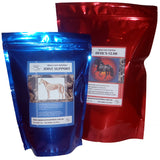What is OCD?
 OCD, or Osteochondritis Dissecans is a developmental orthopaedic disease that is relatively common, and can affect any horse breed. It may be detected as early as 5 months of age or as late as skeletal maturity, but it is commonly diagnosed around 1 year of age. OCD can occur in any joint, but it is most commonly found in the hock, stifle and fetlock, and with less frequency in the shoulder. Bilateral joint involvement is often common: if one fetlock is affected, a veterinarian may well x-ray the other fetlock joint to look for OCD lesions. In one study of OCD in the stifle, 57% of affected animals had bilateral involvement (i.e. OCD in both stifles).
OCD, or Osteochondritis Dissecans is a developmental orthopaedic disease that is relatively common, and can affect any horse breed. It may be detected as early as 5 months of age or as late as skeletal maturity, but it is commonly diagnosed around 1 year of age. OCD can occur in any joint, but it is most commonly found in the hock, stifle and fetlock, and with less frequency in the shoulder. Bilateral joint involvement is often common: if one fetlock is affected, a veterinarian may well x-ray the other fetlock joint to look for OCD lesions. In one study of OCD in the stifle, 57% of affected animals had bilateral involvement (i.e. OCD in both stifles).
In normal joint formation the bone is covered by a smooth, even covering of articular cartilage anchored to the subchondral bone plate which allows the joint to glide smoothly. In OCD there is a disturbance of normal development in the cartilage and subchondral bone plate resulting in areas of weakness. As the horse moves around these weaker areas within the joint are then damaged further and can fracture and detach: areas of articular cartilage can break away from the subchondral bone plate, forming a flap under which synovial fluid can enter resulting in the formation of subchondral cysts; the weak areas may fracture away completely resulting in a free-floating island of tissue (also known as ‘joint mice’) within the joint; or the flap can reattach to the underlying bone resulting in a wrinkled articular joint surface. Such disturbances within the joint can cause swelling and lameness and can damage the surrounding normal cartilage. The most common sign of OCD is swelling of the affected joint, but diagnosis should be confirmed with an x-ray.
It is very likely that a combination of factors are responsible for OCD, including: rapid growth and weight gain; imbalance of hormones such as insulin and thyroid; trauma to a joint; genetic susceptibility; and dietary imbalances, in particular high calorie and/or low in trace minerals especially copper.
Due to the multifactorial nature of the disease preventing OCD can be difficult, but there are some sensible precautions that owners of young animals can take, and that includes making sure their diet is balanced for healthy growth, and that the minerals needed by the body for bone and cartilage development are provided in adequate and balanced quantities.
Minerals required for bone and cartilage development:
Calcium: vitamin D is required in adequate amounts for the absorption of calcium. If phosphorous intake is not adequate, calcium absorption can be affected. If dietary protein is not adequate, calcium absorption can be affected.
Phosphorous: works with calcium in the formation of healthy bones.
Manganese: required for cartilage
Sulphur: required for the formation of cross-bridges between collagen molecules. These add strength and stability to the structure of collagen rich ligaments, tendons and joint tissues.
Copper: required for the production of normal connective tissue, including tendons, ligaments and cartilage joint lining.
Zinc: needed in bone and joint health. Zinc is part of antioxidant enzymes in the body which neutralise free radicals before they can damage normal body tissue.
If you are breeding young stock, or are thinking about it, correctly balancing their diet for healthy development can have a major impact on the life of the horse. The nutrition a horse receives in its first 18 months of life help set the foundations for healthy musculoskeletal development and future athletic potential, or can lead to developmental disorders, such as OCD that can plague the horse for the rest of its life, curtailing a performance career.
|
RELATED PRODUCTS |
|||
 |
 |
 |
 |
| Joint Support | Joint Builder |
Joint Relief |
Omega-3 |